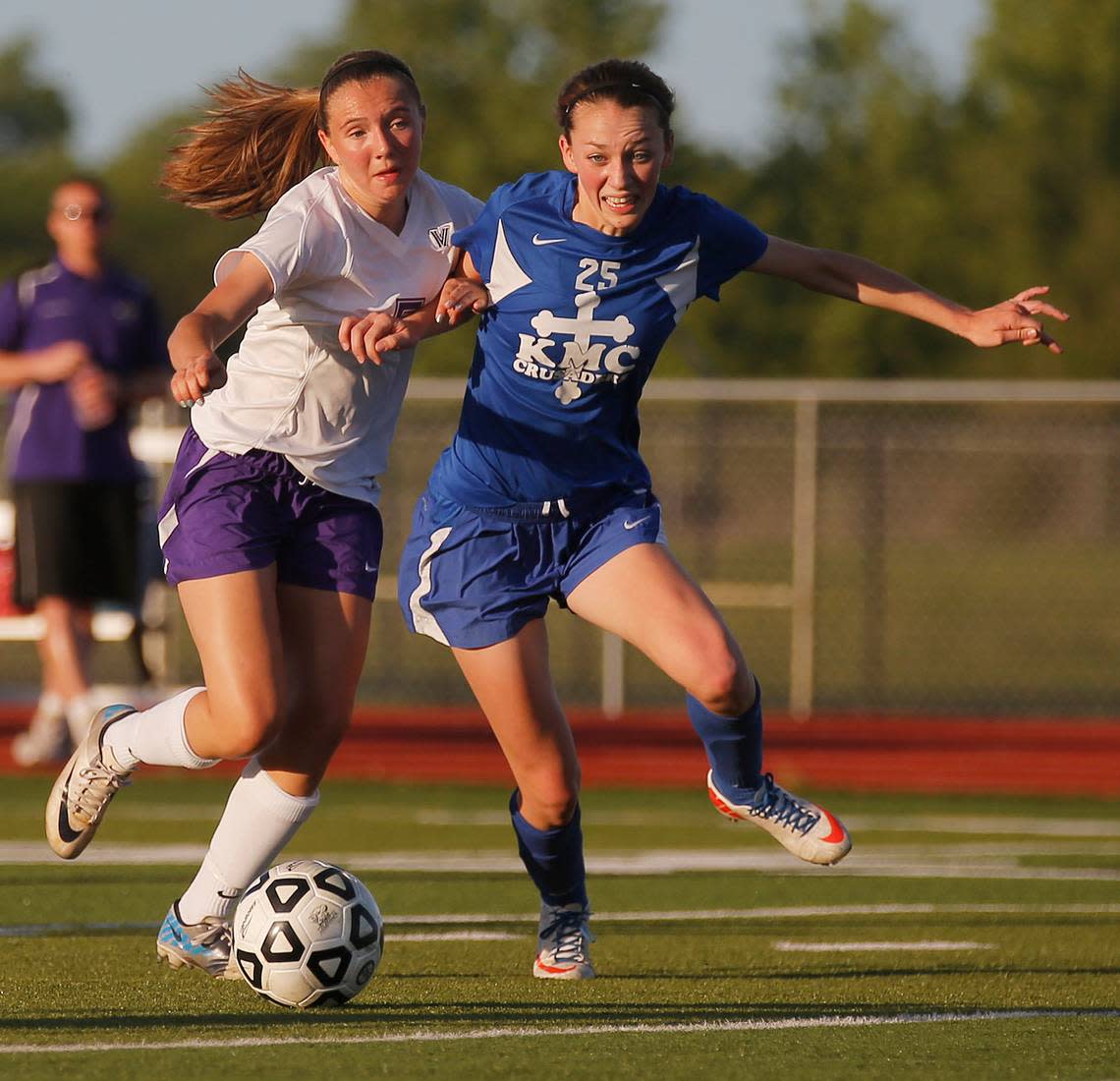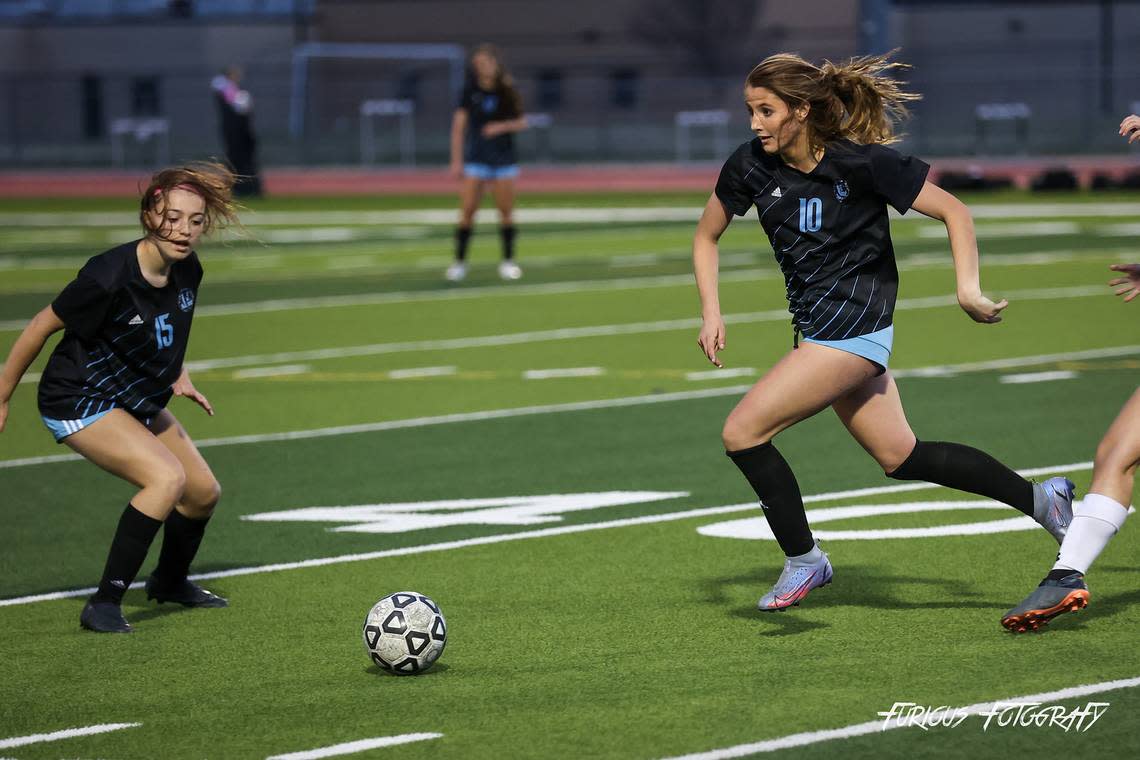Women’s soccer emerging as future option for Wichita State to add as Division I sport
A proposed $51 million project to transform Cessna Stadium opens the door to potentially introducing a Division I women’s soccer team at Wichita State University in the future.
Momentum of adding women’s soccer to the Shockers’ collection of fall sports began building momentum last week when the university’s Board of Trustees and the Kansas Board of Regents gave Wichita State permission to begin designing and fundraising for the complete remodel.
In a move that ends any hope of a college football team returning to Wichita State, the proposal calls for the dilapidated 30,000-seat facility to be razed beginning as early as August 2023 and for a multi-sport complex to be built in its place with a target date of completion by May 2026. The new stadium will seat nearly 11,000 spectators and feature a regulation-sized soccer field.
While a women’s soccer program may not be imminent at Wichita State, first-year athletic director Kevin Saal acknowledged to The Eagle that adding the sport in the coming years is a “makes-sense option.”
“Women’s soccer is incredibly strong in this city and I think you could build it relatively quickly,” Saal said. “It also would add a sport to our fall sports portfolio and when you talk about campus life and student engagement, adding another fall sport would be really good.”
Here’s a close look at what the planned renovations for Cessna Stadium mean for Wichita State and what a potential Division I women’s soccer program could look like in Wichita.

Women’s soccer emerges as leading candidate to add at Wichita State
Adding a women’s sports program at Wichita State is nearing an inevitability due to the population changes in the university’s enrollment.
As a public institution, Wichita State must maintain a 5% variance in athletic scholarships given to its general student population in order to remain compliant with Title IX obligations.
Five years ago, WSU had a near-even split between its male and female students. According to Saal, the split at WSU is approaching 56% female and 44% male, meaning that WSU’s scholarship split must be at least 51% female.
“You’re starting to see the gap widen and there’s only so much we can do with our existing roster management,” Saal said. “We can hold men’s rosters to a minimum and ask women’s rosters to carry this many to help your numbers, but that will only take you so far. At some point, you’re either going to have to drop a men’s sport, which we don’t do here, or you’re going to add a sport. We have to be prepared for growth.”
Research for potentially adding a women’s sport began well before Saal was hired this summer, but the AD said the preliminary discussions that have been had since he joined WSU have been centered around three possibilities: women’s soccer, women’s beach volleyball and women’s bowling.
Women’s soccer has emerged as the first choice, as the infrastructure in the American Athletic Conference is already in place with 12 programs projected to be playing women’s soccer after the dust settles of next summer’s conference realignment that will see Cincinnati, Houston and UCF exit and Charlotte, Florida Atlantic, North Texas, Rice, San Antonio and UAB join. Tulane and WSU are the only members of the AAC that do not currently have a women’s soccer team.
While adding women’s soccer may be the leading candidate, Saal reiterated discussions are still in preliminary stages (WSU has yet to decide if the soccer field would be natural grass or artificial) and creating a program from scratch will require millions of dollars in fundraising before it’s seriously entertained.
“It’s a common misconception that once we got the approval that we have the dollars,” Saal said. “We still have a lot of work to do. We’ve got to fund-raise for it and figure out how we can sustain it and be competitive and not take away from our existing programs.”

Local soccer coaches rally support behind a D1 program in Wichita
Youth soccer coaches seem to be in unanimous agreement that the talent pool for girls soccer players in the Wichita area is as strong as it’s ever been.
FC Wichita owner Blake Shumaker has played a role in that rapid development with his organization’s commitment to girls soccer, bringing Wichita into the prestigious ECNL summer competitions and establishing a semi-professional outdoor women’s soccer team.
Popularity for girls soccer is skyrocketing and adding a local Division I program would only make the Wichita soccer community stronger, Shumaker says.
“We’ve been trying to get girls opportunities to be identified at the next level, so giving them a chance to stay home and be near family would be huge,” Shumaker said. “Outside of the athletic scholarships for local kids, young girls can grow up and watch and aspire to that in Wichita. It could really provide a big opportunity for these local players who are having to go out of state to find a home right now.”
Many of Wichita’s best players have gone to either Kansas or Kansas State in the past decade. KU had a solid pipeline with standouts like Caroline Kastor, Whitney Berry, Grace Hagan and Katie McClure, although a local player hasn’t joined the Jayhawks since 2020. K-State has featured more local talent like Brookelynn Entz, Katie Cramer, Maguire Sullivan, Avery Green, Dora Gallo and Ashley Zane.
Recent top players like East graduate Peyton Martin-Peterson (Jacksonville) and Kapaun Mt. Carmel graduate Makenzie Orr (Northern Iowa) both left their home state in this past recruiting cycle for a Division I opportunity.
Local high school coaches wonder if players of that caliber wouldn’t decide to stay in their hometown if a Division I chance was available.
“There’s more than enough local talent and it would be an unbelievable opportunity and something I think the community has wanted for a long time now,” Maize girls soccer coach Jay Holmes said. “You look at some of my girls, Katie McClure and Ashley Zane, and there is a pretty consistent group of pretty special players that come through Wichita and I think a lot of kids like that would entertain staying home and playing for a hometown Division I program.”
If a WSU women’s soccer program could convince local talent to stay in their hometown, high school coaches believe the Shockers could be competitive in their infancy.
“Realistically, you would have to step outside the area to build a team, but you could absolutely build a core from the local area,” Bishop Carroll girls coach Greg Rauch said. “If you look at the numbers and the technical training that these kids get from such a young age now, Wichita is starting to catch up in the scene. These kids are exposed to top-level competition and training right off the bat, so it’s pretty cool to see the growth. I think (WSU) could be a legit contender right off the bat.”

Will Kansas high school state track meet be impacted by Cessna renovations?
Demolition and construction will be scheduled around the month of May every year to ensure Cessna Stadium can continue to host the Kansas high school state track and field meet.
But the question remains if the finished version of the project, a stadium estimated to hold between 10,000 and 11,000 spectators, would provide sufficient enough seating for the largest high school state track and field meet in the country.
While the crowds are always split between classifications on the first day of the state track meet, WSU estimates somewhere around 12,000 people come to watch on the second day when every classification is running finals on the track.
That seems to present a potential seating problem, but Saal is confident enough space will be available with the project as planned.
“You have to remember that the 12,000 is for the entire day on Saturday, but that doesn’t mean they’re all there at the same time,” Saal said. “It’s rare to sit there and watch an entire track meet. I think a lot of people are coming and going, so we feel like it’s the right size and we certainly had those conversations with the Kansas high school state track administrators.
“And the beauty of the design is that you have significantly more concourse space. You have grass berms for people to lay out on and then you have even more space beyond the concourse space and other grass areas.”
While adding a soccer field will draw most of the attention from the proposal, Saal said he believes the project will give WSU a “premier track and field facility” capable of hosting signature events from the college to the youth level.
There remains significant questions about the final product from a track-and-field perspective, however. The rendering released by the university earlier this week did not feature a place for a shot put ring or a steeplechase pit, two key features for hosting high-level track and field events. The track oval will have to be widened to fit a regulation-sized soccer field, so another question would be the width of the lanes and if it would be an 8-lane or 9-lane track.
Saal emphasized there is still plenty of time to find answers to those questions and that the sketch drawing should not be considered anywhere close to a final product. The AD also confirmed that WSU track and field coach Steve Rainbolt would be consulted and involved closely with the design of the track portion of the facility.
“It would be a great facility to host NCAA track regionals,” Saal said. “It would be a great place to host junior national championships and that can be a really great recruiting tool for your program if you can get those at your place. And then you think about the external events we could host, whether that’s high school soccer or maybe even high school football. It can be a very versatile facility.”
